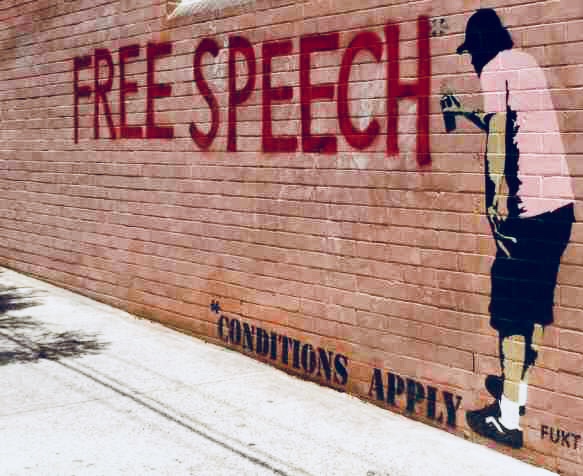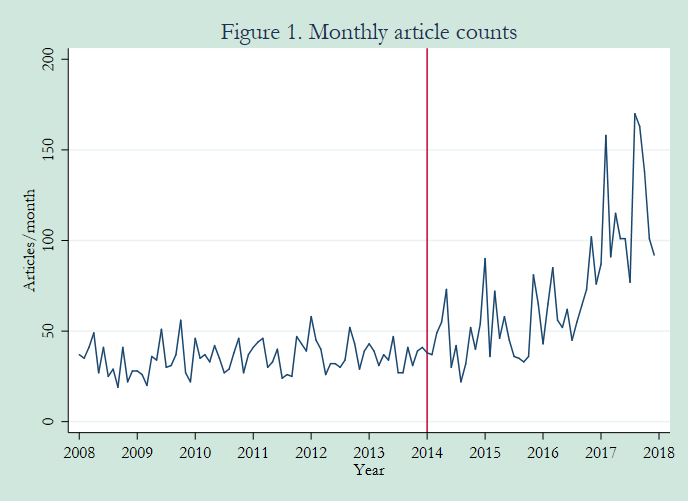Free Speech on College Campuses
Exploring US newspaper coverage from 2008-2017

A Painful Lesson, A Violent Attack on Free Speech at Middlebury, The Mob at Middlebury, and The Dangerous Safety of College. These are just a few of the headlines from the aftermath of student demonstrations and protests against Charles Murray at Middlebury College in 2017. In recent years, highly publicized incidents like this one have ignited a national debate over whether there is a “free speech crisis” on college campuses. Earlier this year, a study from the Free Speech Project at Georgetown University found that any notion of a crisis is, as summarized by Zach Beauchamp in an article on Vox, “more than a little overblown. There have been relatively few incidents of speech being squelched on college campuses, and there’s in fact limited evidence that conservatives are being unfairly targeted.”
Given these findings, why is there a widespread perception of a free speech crisis? How does media coverage of this issue contribute to the crisis narrative on college campuses around the United States?
To find out, we collected every article containing terms related to free speech and college campuses published in 11 national and regional papers in the decade between January 1, 2008 and December 31, 2017, amounting to nearly 6,000 articles. We wondered two things: First, has there been a noticeable increase in the number of articles about free speech on college campuses in recent years? Second, has there been a shift in the tone and types of articles published over time?

Figure 1 illustrates the number of articles in our dataset published over time. This confirms that there has in fact been an increase in the coverage of free speech on college campuses. Comparing left and right of the red line, the newsworthiness of the topic takes off in early 2014, and jumps again starting in late 2016. It turns out that only 43 percent of articles from our sample were published during the first six years of our time period (2008-2013), while the remaining 57% of articles in our sample were published in the last four (2014-2017).
After examining the total number of articles about free speech, we wondered how positive or negative those articles were. The Media Portrayals of Minorities Project uses a method involving dictionaries of positive and negative words (such as “beautiful” or “attack”) to gauge the tone of individual articles. Roughly speaking, negative articles contain more negative than positive words, and vice versa. Each set of articles about a particular topic is calibrated against a representative sample of over 48,000 randomly selected newspaper articles, which itself has an average tone we set at zero to provide a baseline for comparison. We found that articles about free speech on college campuses are significantly more negative than the most newspaper articles. In fact, the average article about free speech is more negative than 66 percent of articles in our representative corpus. In addition, articles published after January 1, 2014 are over 30 percent more negative than those published prior to that date.
In comparing the articles from the earlier and later time periods, there also appears to be a difference in the main topics discussed in coverage of free speech on college campuses. Using our topic modeling methodology, we found that articles published before 2014 talked about free speech mainly in the context of the government, courts of law, technology (privacy, censorship, etc.), and politics (elections and campaigns). Articles about free speech on campus published after 2014 touched on more specific people and incidents including Milo Yiannopoulos, Charlottesville, the San Francisco 49ers and the NFL, the protests at Berkeley, and the Charlie Hebdo attack.
This apparent shift in the themes in stories about free speech on campus suggests that articles are moving from covering the issue in a more general and thematic manner to a more sensationalized, episodic approach; one in which the violence of attacks and protests about free speech are increasingly highlighted, possibly driving the trend of an increasingly negative tone of articles over time.
Altogether, our findings shed light on the wider social context in which the debate about a “free speech crisis” is transpiring. Highly controversial and violent incidents likely drive not only an increase in media coverage, but also increasingly negative coverage of free speech on campus.
-Mira Chugh & Will DiGravio
Methodological note: We examined 5,888 articles that mentioned free speech on college campuses in the New York Times, Washington Post, USA Today, Richmond Times, Philadelphia Inquirer, Philadelphia Daily News, New York Post, New York Daily News, Minneapolis Star, Tampa Bay Times, and Atlanta Journal. Our analysis looked at articles published in the period from January 1, 2008 to December 31, 2017. Articles were selected using the following search terms: (“free speech” OR “freedom of expression” OR “freedom of speech”) AND (“college!” OR “universit!” OR “campus!”). We used techniques including lexical sentiment analysis, regression analysis, collocation analysis, and topic modeling. For more information on our methods, please click here.